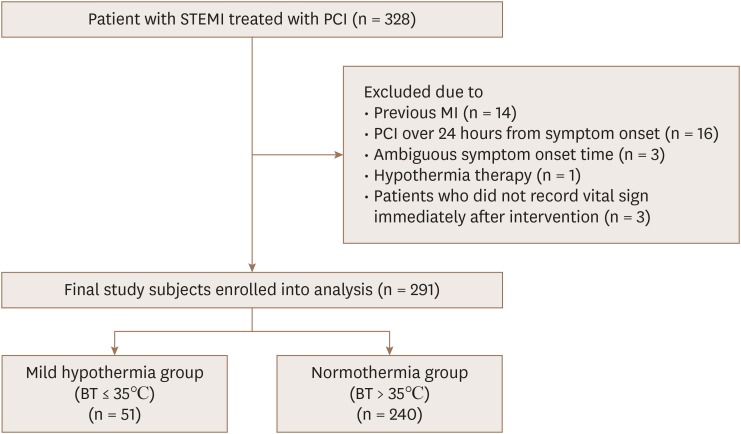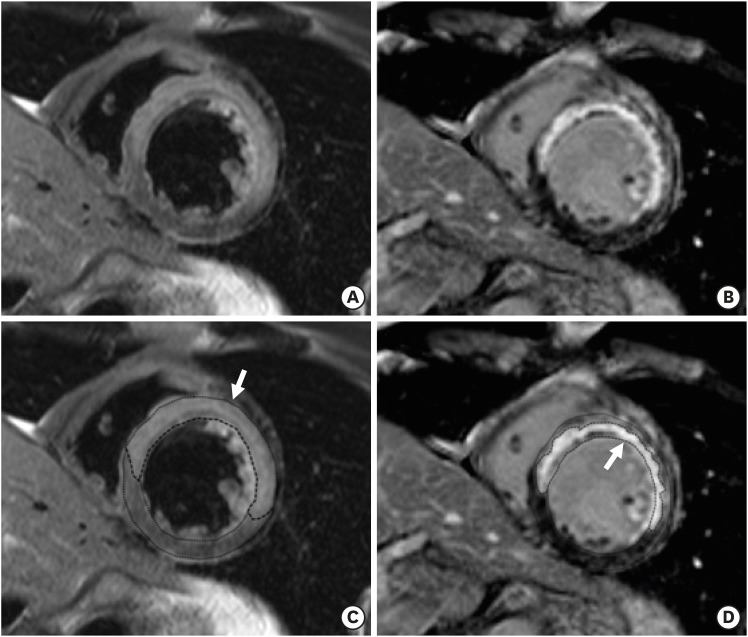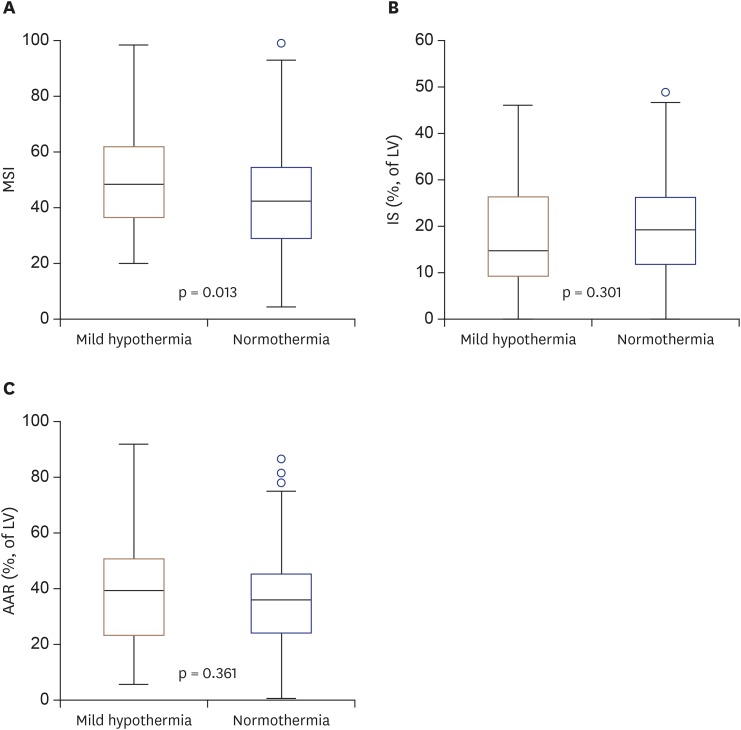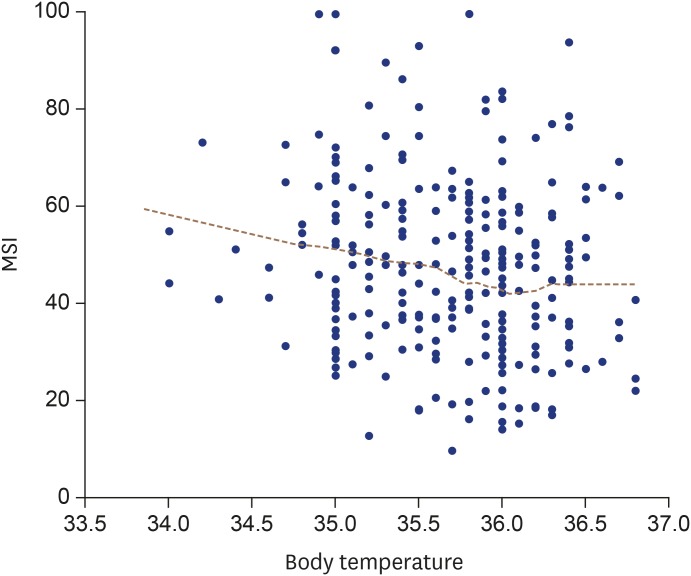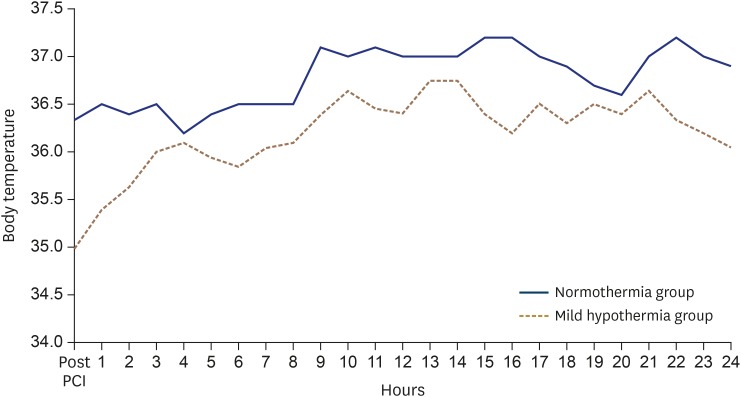J Cardiovasc Imaging.
2018 Sep;26(3):175-185. 10.4250/jcvi.2018.26.e21.
Impact of Natural Mild Hypothermia in the Early Phase of ST-Elevation Myocardial Infarction: Cardiac Magnetic Resonance Imaging Study
- Affiliations
-
- 1Division of Cardiology, Department of Internal Medicine, Samsung Medical Center, Sungkyunkwan University School of Medicine, Seoul, Korea. youngbin.song@gmail.com
- KMID: 2429859
- DOI: http://doi.org/10.4250/jcvi.2018.26.e21
Abstract
- BACKGROUND
Mild hypothermia (32-35°C) during acute myocardial ischemia has been considered cardioprotective in animal studies. We sought to determine the association of between natural mild hypothermia and myocardial salvage as assessed by cardiac magnetic resonance imaging (CMR) in ST-elevation myocardial infarction (STEMI) patients undergoing primary percutaneous coronary intervention (PCI).
METHODS
In 291 patients with STEMI, CMR was performed a median of 3 days after the index event. Body temperature was collected for 24 hours after PCI. Fifty-one patients (17.5%) had natural mild hypothermia (less than 35°C) during the day after PCI, and 240 (82.5%) did not.
RESULTS
The primary endpoint, the myocardial salvage index, was significantly higher in the natural mild hypothermia group than in the normothermia group (median [IQR], 50 [37-64] vs. 43 [30-56], p = 0.013). The myocardial area at risk between the 2 groups did not differ (39 [22-51] vs. 35 [24-44], p = 0.361), nor did the infarct size (16 [10-28] vs. 20 [12-27], p = 0.301), presence of microvascular obstruction (57% vs. 60%, p=0.641), or hemorrhagic infarction (43% vs. 46%, p = 0.760). A multivariable linear regression showed a significant association between the lowest body temperature and myocardial salvage index (β = -0.191, p = 0.001).
CONCLUSIONS
In patients with STEMI undergoing primary PCI, natural mild hypothermia within 24 hours is associated with greater salvaged myocardium.
Keyword
MeSH Terms
Figure
Reference
-
1. Nolan JP, Morley PT, Hoek TL, Hickey RW. Advancement Life support Task Force of the International Liaison committee on Resuscitation. Therapeutic hypothermia after cardiac arrest. An advisory statement by the Advancement Life support Task Force of the International Liaison committee on Resuscitation. Resuscitation. 2003; 57:231–235. PMID: 12858857.2. Nolan JP, Deakin CD, Soar J, Böttiger BW, Smith G. European Resuscitation Council. European Resuscitation Council guidelines for resuscitation 2005. Section 4. Adult advanced life support. Resuscitation. 2005; 67(Suppl 1):S39–S86. PMID: 16321716.3. Miki T, Liu GS, Cohen MV, Downey JM. Mild hypothermia reduces infarct size in the beating rabbit heart: a practical intervention for acute myocardial infarction? Basic Res Cardiol. 1998; 93:372–383. PMID: 9833149.4. Duncker DJ, Klassen CL, Ishibashi Y, Herrlinger SH, Pavek TJ, Bache RJ. Effect of temperature on myocardial infarction in swine. Am J Physiol. 1996; 270:H1189–H1199. PMID: 8967356.5. Hale SL, Kloner RA. Myocardial temperature in acute myocardial infarction: protection with mild regional hypothermia. Am J Physiol. 1997; 273:H220–H227. PMID: 9249493.6. Tissier R, Ghaleh B, Cohen MV, Downey JM, Berdeaux A. Myocardial protection with mild hypothermia. Cardiovasc Res. 2012; 94:217–225. PMID: 22131353.7. Hale SL, Kloner RA. Mild hypothermia as a cardioprotective approach for acute myocardial infarction: laboratory to clinical application. J Cardiovasc Pharmacol Ther. 2011; 16:131–139. PMID: 21149829.8. O'Neill WW, Dixon SR. The year in interventional cardiology. J Am Coll Cardiol. 2004; 43:875–890. PMID: 14998632.9. O'Neill WW, Dixon SR, Grines CL. The year in interventional cardiology. J Am Coll Cardiol. 2005; 45:1117–1134. PMID: 15808773.10. Erlinge D, Götberg M, Lang I, et al. Rapid endovascular catheter core cooling combined with cold saline as an adjunct to percutaneous coronary intervention for the treatment of acute myocardial infarction. The CHILL-MI trial: a randomized controlled study of the use of central venous catheter core cooling combined with cold saline as an adjunct to percutaneous coronary intervention for the treatment of acute myocardial infarction. J Am Coll Cardiol. 2014; 63:1857–1865. PMID: 24509284.11. Eitel I, Desch S, Fuernau G, et al. Prognostic significance and determinants of myocardial salvage assessed by cardiovascular magnetic resonance in acute reperfused myocardial infarction. J Am Coll Cardiol. 2010; 55:2470–2479. PMID: 20510214.12. Dae MW, Gao DW, Sessler DI, Chair K, Stillson CA. Effect of endovascular cooling on myocardial temperature, infarct size, and cardiac output in human-sized pigs. Am J Physiol Heart Circ Physiol. 2002; 282:H1584–H1591. PMID: 11959619.13. Stowe DF, Fujita S, An J, Paulsen RA, Varadarajan SG, Smart SC. Modulation of myocardial function and [Ca2+] sensitivity by moderate hypothermia in guinea pig isolated hearts. Am J Physiol. 1999; 277:H2321–H2332. PMID: 10600852.14. Kusuoka H, Ikoma Y, Futaki S, et al. Positive inotropism in hypothermia partially depends on an increase in maximal Ca(2+)-activated force. Am J Physiol. 1991; 261:H1005–H1010. PMID: 1928384.15. Hamamoto H, Sakamoto H, Leshnower BG, et al. Very mild hypothermia during ischemia and reperfusion improves postinfarction ventricular remodeling. Ann Thorac Surg. 2009; 87:172–177. PMID: 19101292.
- Full Text Links
- Actions
-
Cited
- CITED
-
- Close
- Share
- Similar articles
-
- Advanced Cardiac MR Imaging for Myocardial Characterization and Quantification: T1 Mapping
- Serum Myoglobin in the Early Phase of Acute Myocardial Infarction
- Prognostic Impact of Early ST-Segment Resolution and Biochemical Markers in Patients With ST-Elevation Myocardial Infarction
- ST segment
- Therapeutic Hypothermia for Cardioprotection in Acute Myocardial Infarction

